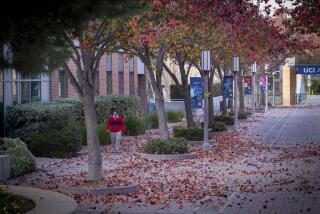A track record of helping schools
During her six years as Arizona governor, Janet Napolitano, a Democrat, secured a $1-billion bond to build new facilities for the state’s universities, signed a law that boosted state contributions to financial aid and approved a special fund to retain professors -- all with a Republican-controlled Legislature.
During sensitive negotiations, Napolitano would often excuse aides from the room and speak to the Republican leaders of the House and Senate alone, according to Arizona education officials.
“When we heard that, we laughed because we knew she was a master of the details,” said Peter Likins, who was president of the University of Arizona during most of Napolitano’s tenure. “There was no two-on-one advantage because she had such a magnificent understanding of the budget.”
“She got most of what she wanted,” Likins added.
Napolitano was confirmed Thursday by University of California regents as the system’s next president. During a brief speech and news conference, she listed some of her accomplishments as governor but gave little hint as to what her priorities would be.
“I will bring with me my history as governor, where I spent much of my time investing in Arizona’s universities, fighting to keep tuition for students as low as possible, while helping to create a new medical school in downtown Phoenix, a new research organization to foster university [research and development] and loan-forgiveness programs for high-demand fields of study,” she said.
Napolitano has declined interview requests, but her time as governor offers a glimpse into her interests and priorities as she prepares to lead the 10-campus California system.
She was elected governor in 2003 and left office in 2009, when she became the head of the U.S. Department of Homeland Security, an agency with an annual $60-billion budget and 240,000 employees. There, she sometimes antagonized both liberals and conservatives with her stances on deportations and airport security.
As Arizona’s top elected official, she had a seat on the state’s 12-member regents board, which oversees three public universities. Napolitano crafted the budget -- now at $4.2 billion -- for a system that currently enrolls about 139,000 students.
Her experience there will help as she takes over the UC system in September, the first female president in its 145-year history. UC has an annual budget of $24 billion, 230,000 students, five medical centers and three national laboratories.
In addition to securing funding for buildings and professors, Napolitano placed an emphasis on medical and science facilities, pushing through a controversial plan to put a medical school in Phoenix and increasing funding for research facilities.
Napolitano argued that the moves would help the state fill shortfalls in its workforce and pushed colleges to produce more nurses, teachers and engineers.
“If we are serious about expanding opportunity, we must recognize that it depends on high skills, higher education and learning that lasts a lifetime,” she said at the time.
Her decisions may have also been influenced by her family history, Arizona higher-education officials said.
Her father was the longtime dean of the University of New Mexico School of Medicine.
“If you grow up in a medical family, I guarantee that has a lasting impact on a child at all ages,” said David S. Alberts, the Arizona Board of Regents professor of medicine who worked with Napolitano on a project to study cancer.
Locating the medical school in Phoenix was one of Napolitano’s most difficult tasks, supporters say. Previously, doctors in training could go only to the University of Arizona’s Tucson campus, and several college presidents had agreed to build a new facility in the state’s most populous city.
But the venture “really unearthed and made public the rivalry between” the University of Arizona and Arizona State University, two schools that had agreed to participate, said Anne Mariucci, whom Napolitano appointed to the board of regents.
“There were days when it seemed like it would never, ever work out,” Mariucci said.
Napolitano was able to get the schools to agree on how to share resources, even calling the president of Arizona State University into her office for what was supposed to be a private meeting.
“Everyone outside could hear the language,” Mariucci said.
“She took him to the woodshed.”
The medical school opened in 2006, although Arizona State University later dropped out of the program.
“The only person in the state ... who could have brought those people together was Janet Napolitano,” Mariucci said.
Even her political opponents seemed to begrudgingly respect Napolitano’s persuasiveness.
Former Senate Majority Leader Thayer Verschoor criticized Napolitano’s 2008 budget as too short-sighted and for expanding services when the state was facing a $2-billion shortfall.
“She has so many things out there that I think she probably got most of the things she really wanted,” he later said, according to the Arizona Republic. “Her playbook has always been along those lines.”
Legislators also voted to freeze tuition for four years for students who began the 2007 school year at the University of Arizona and Arizona State. They also approved $5.8 million to increase the salaries of key professors to keep them from leaving for other universities.
“She was a strong proponent of higher education, especially in medical and technology development,” Alberts said. “We had a propensity of training outstanding faculty and then seeing them leave, so that money made a difference.”
Some UC schools have struggled to retain top faculty. Recently, USC was able to lure two top neuroscientists and their team from UCLA with the promise of better facilities.
During Napolitano’s tenure, the state also approved giving universities a supplement of nearly $1.4 million annually to double the number of nurses in the state, although the number of undergraduates who received nursing degrees did not dramatically increase during that time.
Napolitano, who was criticized by some protesters last week for supporting U.S. programs that led to deportations, was a strong supporter of diversity, said Arizona regent LuAnn Leonard, who became the first Native American regent when Napolitano named her to the board in 2008.
As governor, Napolitano always had a Native American on her staff, and “she really valued those relationships,” Leonard said.
“She really made a concerted effort to reach out to us,” she said.
“I know she has that desire to make sure everyone has a voice.”
Likins said Napolitano didn’t approve every request he or other presidents had made.
“You didn’t get whatever you wanted,” he said. “But she understood the power of the university.”
--
More to Read
Sign up for Essential California
The most important California stories and recommendations in your inbox every morning.
You may occasionally receive promotional content from the Los Angeles Times.











